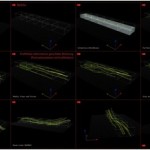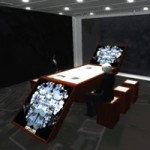Agent based technology
In order to implement web-service orientated application through whole phases of product development, the next generation of virtual prototyping will need to draw heavily on agent-based and emerging technology (Tah, 2005)[1]. The nature of complexity considering design environments, characterizes creative design projects as complex adaptive systems that depend on multi-agent systems’ solutions. The interaction between multiple agents in the system results in an emergent behavior of the overall system. Tah claims that: “it has been widely acknowledged that the agent-based approach provides a metaphor and framework for channeling problem- solving approaches from diverse disciplines into the design of software systems capable of handling complexity.”
A software agent is according to Wooldridge and Jennings “a self-contained program capable of controlling its own decision making and acting, based on its perception of its environment, in pursuit of one or more objectives”[2]. Their definition of agents contemplates four main attributes that determinate agenthood:
- “Autonomy: The ability to function largely independent of human intervention
- Social ability: The ability to interact ‘intelligently’ and constructively with other agents and/or humans
- Responsiveness: The ability to perceive the environment and respond in a timely fashion to events occurring in it
- Pro-activeness: The ability to take the initiative whenever the situation demands” (Wooldridge and Jennings, 1995)
Agents are operating in open, complex, dynamic, and distributed environments. Agents interact with other agents, which may include both people and software. This exploits aspects of the emerging visions of the Web 2.0 and ubiquitous computing in which agents come together to deliver unite results. An enabling platform supports such working methods by implication of self-organization in order to handle dynamism in contemporary open computing environments. Those self-organizing systems function without central management, where complex collective behavior emerges from actor’s mutual interactions. Within such a system agents modify system’s structure and functionality to adapt to changes in requirements and the environment based on previous experience. Therefore, new theories of emergence are being developed[3] based on inspiration from natural or social systems (Wooldridge and Jennings, 1995). During the development of A.N.D.I. system by ORTLOS lot of work has been undertaken in the area of trust among agents, in order to make appropriate decisions. “The field of trust, reputation and social structure seeks to capture human notions such as trust, reputation, dependence, obligations, permissions, norms, institutions and other social structures in electronic form” (Ashri et al., 2006; Garcia-Camino, 2006)[4]. Garcia-Camino underlines: “the need to properly assign roles, powers, rights and obligations to agents, in order to handle security and trust aspects in an open online environment, is becoming increasingly important.”
Communication technologies and techniques between agents is upmost importance[5]. Luck found out that: “there is a need for mechanisms that allow agents to coordinate their actions automatically without the need for top-down supervision in many applications. Important step is to develop a wide range of different types of coordination and cooperation mechanisms, such as: coordination protocols (which structure interactions to reach decisions); emergent cooperation (which can arise without any explicit communication between agents); coordination media (or distributed data stores that enable asynchronous communication of goals, objectives or other useful data); and distributed planning (which takes into account possible and likely actions of agents in the domain)“ (Luck et al., 2005).
According to my research, although a lot off agent-based applications have been envisioned, developed, prototyped and evaluated, no one has yet built a robust and fully functional multi-agent system that has been successfully deployed in architectural practice. Currently, “there is a lack of sophisticated software tools, techniques and methodologies to support the specification, development, integration and management of agent systems compared to more mature technologies” (Tah, 2005). Furthermore, according to Tah, there is a need for further work on knowledge gaining in multi-agent contexts. “There is still a lack of mechanisms for explaining and tracing the reasoning behind results and outputs produced by agent-based applications. Mechanisms need to be developed that allow users to trace how particular outputs have been produced in order to inspire future projects and reuse already gained experience in more dynamic interactive way. Further challenge is to bridge the semantic gaps between multiple systems, e.g. to realize scalable and practically usable ontologies between systems using different ontologies.” Additionally, particularly in architectural design, there is a need for a model of digital representation that can provide the basis of a common language that can be understood by multiple agents from various disciplines. The model itself needs to be defined at a level of information resolution that allows for computational interpretation and reasoning (Tah, 2005).
Nevertheless, Tah found out that: “a number of emerging technologies that, when used in combination with agent technologies, present very interesting prospects in realizing sophisticated virtual prototyping systems in the future[6]:
- Ontology based integration – as a way of describing and representing information and knowledge about design projects in a manner that allows us to handle its inherent complexity, share a common understanding and develop software systems that interoperate with each other.
- Semantic web – for the development of a common language for the exchange of semantically rich information between software agents.
- Web services and service-oriented computing – distributed systems can be characterized as collections of service provider and service consumer software components that can be loosely coupled to provide specific application functionally.
- Pervasive computing technologies – the creation of physical environments augmented with embedded computing and wireless communication, yet gracefully integrated with human users. The user-friendly information and communication technologies can become an integral part of the workspace environment, with integrated nano- and micro-processors, sensors and actuators connected via high-speed wireless networks and accessible through a variety of new ergonomically appropriate multimodal interfaces and visualization devices.
- Ambient intelligence – an environment of software components interacting to support user-centered goals and activity, and suggests a component-oriented view of the world in which the components are independent and distributed. Such interactions take place between pairs of agents (in one-to-one collaboration or competition), between groups (in reaching consensus decisions or acting as a team) and between agents and the infrastructure resources that comprise their environments (such as large scale information repositories), in which groups of agents come together to form coherent groups able to achieve common objectives.
- Intelligent virtual agents – First-generation purely geometric models have advanced to more elaborate physics-based models for animating particles, rigid bodies, deformable solids, fluids and gases. We can now simulate and animate a variety of real-world, physical objects with stunning realism. In recent years, research in behavioral modeling has progressed towards self-animating characters that react appropriately to perceived environmental stimuli. Cognitive modeling using AI techniques, including knowledge-representation, reasoning and planning, is applied to produce characters with some level of intelligence that mimic real-world phenomena. They are autonomous, graphically embodied agents in an interactive, 2D or 3D virtual environment and they are able to interact intelligently with the environment.” (Tah, 2005)
[1] Joseph Tah, “Towards an agent-based construction supply network modeling and simulation platform”, Automation in Construction 14/3 (2005), 353-359.
[2] Wooldrige and Jannings, “Intelligent agents: Theory and practice”, The Knowledge Engineering Review 10/2 (1995), 115.
[3] Ashri et al, “Using electronic institutions to secure grid environments”, Proceedings of the Tenth International Workshop CIA 2006 on Cooperative Information Agents (University of Edinburgh, 2006), 461-475
[4] Garcia-Carmino, “A rule-based approach to norm-oriented programming of electronic institutions”, ACM SIGecom Exchange 5/5 (2006), 33-40
[5] Luck et al, Agent Technology: Computing as Interaction. A Roadmap for Agent Based Computing (University of Southampton, 2005)
[6] Joseph Tah, “Future agent-driven virtual prototyping environments”, in Virtual Futures for Design, Construction & Procurement, Ed. Peter Brandon and Tuba Kocatürk (Oxford: Blackwell Publishing, 2008), 213-226











You must be logged in to post a comment.